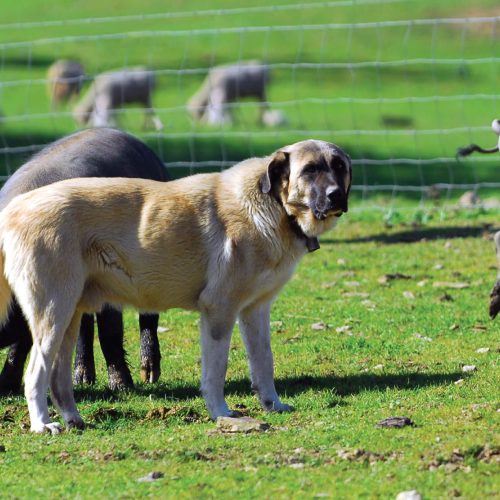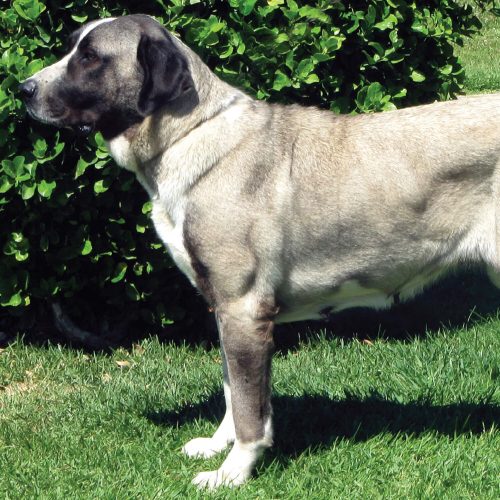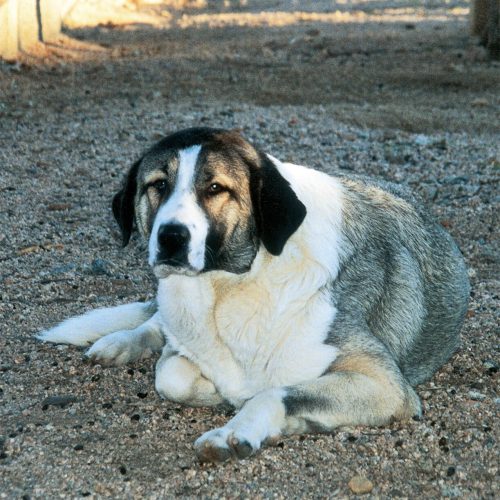Alentejo Mastiff
Portuguese breed recognized by the FCI
Origin | Portugal |
Date of publication of the original valid standard | 04-11-2008 |
Utilization | Guard dog for property and livestock. |
F.C.I. Classification | Group 2 – Pinscher and Schnauzer, Molossoid breeds, Swiss Mountain and Cattle Dogs.
Section 2.2. – Molossoid breeds, Mountain type. Without working trial. |
Height and Weight | Height at the withers:
Males: 66-74 cm. Females: 64-70 cm. Weight: Males: 45-60 Kg. Females: 35-50 Kg. |

Brief Historical Summary
It is believed to descend from molosser dogs from the Middle East. On account of their size and courage they were used by tribes whose livelihood depended on livestock husbandry, thus performing a crucial role for this type of community.
With the beginning of the transhumance, which implies temporary displacement of large flocks, it was noticed that they were exposed to many dangers during their long journeys. On their route to the mountains in the summer and back to the plains in the winter, flocks were always accompanied by large dogs, which lead to the latter being spread along the route from region to region. Thus is explained the appearance of this powerful dog, in the Alentejo plains, which has been called Rafeiro do Alentejo since the end of the 19th century.
Behaviour/Temperament
An excellent farm and estate watch dog, it is also a very useful livestock protector, more vigilant at night, being very serious when guarding territory or any other property entrusted to it.
It has a calm and confident expression, neither aggressive nor shy.
General Appearance
Large sized dog, powerful, rustic, sober and calm. Outlines in head slightly convex, the general structure is rather longer than high (sub-longilinear).
Important Proportions
Rectangular (Sub-longilinear), with height at withers slightly inferior to body length.
Skull width and head length should have a relation of 1/2. Muzzle and skull length should have a relation of 2/3.
Chest depth should be slightly less than half the height at withers.
Head
Voluminous tending to massive, in proportion to the size of the dog; wide at the rear of the skull, narrower and less convex in the forehead. The superior cranium-facial axes are moderately divergent.
Cranial Region
Skull: Broad; rounded in both the longitudinal and transversal axes; superciliary arches not prominent; slight frontal furrow between and over the eyes; occipital protuberance not too pronounced; well muscled sides of the skull.
Stop: Not pronounced.
Facial Region
Nose: Oval, with tip slightly downwards and towards the rear part of muzzle; black coloured well open nostrils.
Muzzle: Nasal bridge straight, its cross section arched. The muzzle has a wide and high base, tapering moderately towards the nose and is shorter than the skull.
Lips: Black, slightly rounded in front, overlapping, well cut; of medium thickness; showing a slight curve in the inferior profile.
Jaws/Teeth: Strong and well developed; scissors bite, pincer bite accepted.
Cheeks: Slightly evident with prominent masseteric area.
Eyes: Small; elliptical; set almost level with the foreface; brown (preferably dark); dark pigmented lids; firm and adherent to the eyes. With a calm expression.
Ears: Medium set-on, with low mobility, folded and hanging. Small, with a narrow base and length equal to or slightly more than the width; Triangular and rounded at the tip. At attention they remain folded, rising at the base and folding vertically.
Neck
Well set into the shoulders; straight; short; strong; with even, single, longitudinal dewlap, proportioned to the size.
Body
Strong, well muscled, slightly longer than the height at the withers, voluminous.
Top line: Straight, almost level; a slight slope from fore to rear is tolerated.
Withers: Not prominent, well connected to the neck.
Back: Slightly sloping tending to horizontal.
Loin: Of medium length; straight and broad, well muscled.
Croup: Slightly sloping; of medium length; broad and muscled, in relation to the substance.
Chest: Broad; well let down to, or slightly below the elbow.
Fore chest: Broad, but not too evident.
Ribs: Well sprung; slightly inclined towards to the back.
Underline and belly: Almost horizontal sternum; belly not tucked up, following the line of the sternum.
Tail
Set on at medium height following the croup; thick at the base, may be slightly curved or turned up at the tip, but no kink, long; at rest hangs down reaching at least the hock, preferably below it, in action it may rise and curl without resting on the top line.
Forequarters
Strong, wide apart, upright when seen from front and from profile.
Shoulder: Strong; of medium length; well developed and muscled, approximately 105º scapula-humerus angle.Upper arm: Strong; of medium length; inclined and muscled.
Elbow: Close to the thorax, neither turning in nor out; humerus-radius angle between 130º and 135º.
Forearm: Vertical; long; strong and well muscled.
Carpus (Pastern joint): Thick; with good joints.
Metacarpus (Pastern): Of medium length; thick; slightly sloping.
Forefeet: Toes thick, tight (not splayed) and slightly arched (rounded); strong nails, coloured according to the coat colour; pads thick and tough.
Hindquarters
Strong, wide apart, upright when seen from back and profile.
Thigh: Long; broad; well muscled but not exaggerated; hip-femur angle approximately 105º.Stifle joint: Strong joint; in line with the body without turning out; femur-tibia angle between 125º and 130º.
Second thigh: Strong; moderately inclined; of medium length; well muscled.
Hock: Strong; lean, of medium height; tibia-tarsus angle approximately 140º.
Metatarsus (rear pastern): Thick, of medium length, set at medium height; very slightly sloping; may have single or double dewclaws.
Hind feet: Toes thick, tight (not splayed) and slightly arched; strong nails, coloured according to the coat colour; pads thick and tough.
Gait/Movement
Heavy, slow, roll without exaggeration.
Skin
Thick, rather close fitting; internal mucous membranes partially or totally pigmented with black, external mucous membranes fully pigmented.
Coat
HAIR: Short or of medium length, this being preferred; thick, straight and dense, evenly spread down to between toes.
COLOUR: Black, wolf grey, fawn or yellow, with or without brindling, always with white markings; or white with patches of these colours.
Faults
Any departure from the foregoing points should be considered a fault and the seriousness with which the fault should be regarded should be in exact proportion to its degree and its effect upon the health and welfare of the dog.
Behaviour: Shyness.
Appearance: Bad overall condition, thinness or obesity.
Muzzle: Long, narrow, slightly curved in profile, with vertically truncated nose.
Backline: Carp or saddle back.
Croup: Long, too sloping down, narrow.
Tail: High or low set.
Limbs: Cow hocked or too wide in the front; incorrect angulation and lack of uprightness of pasterns.
Feet: Disproportioned to the body size, splayed or hare feet.
Coat: In poor condition; long hair; wire or wavy hair.
Severe Faults
General Appearance: Light build or lymphatic.
Head: Not proportioned to the size, lack of volume, pronounced stop, flat and narrow skull, parallel longitudinal superior cranium-facial axes.
Eyes: Light coloured, not elliptical, slanted, lids not very adherent to the eyeball.
Ears: Big, rounded, not folded, not hanging, partially cropped.
Neck: Absence of dewlap; too folded or double dewlap.
Chest: Narrow and flat ribs.
Tail: Curled when at rest, hook at the tip; short. Docked.
Mucous membranes: Partial external lack of pigmentation of the mouth, eyelids, lips and nose.
Height: Males: less than 66 cm or more than 75 cm. Females: less than 64 cm or more than 71 cm.
Eliminating Faults
Behaviour: Aggressive or overly shy.
Type: Atypical.
General appearance: Extremely light in build or very lymphatic.
Head: Very narrow and long.
Muzzle: Too long; convex profile.
Jaws: Undershot or overshot.
Eyes: Too light, of different sizes and colour.
Ears: Very bad set, excessively big and round.
Tail: Anurous.
Mucous membranes: Total lack of pigmentation (albinism) of the mouth, lips and nose.
Coat: Too short.
Notes:
Any dog clearly showing physical or behavioural abnormalities shall be disqualified.
N.B.: Male animals should have two apparently normal testicles fully descended into the scrotum.














